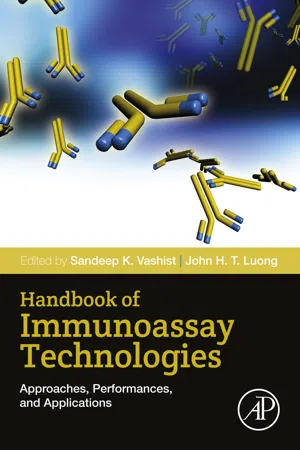1. Overview of Immunoassays
Immunoassays (IAs) play a critical role in various bioanalytical settings, such as clinical diagnostics, biopharmaceutical analysis, environmental monitoring, security, and food testing. During 1995–2017, a wide range of IAs have been developed to provide the quantitative, semiquantitative, or qualitative detection of analytes. The precise early-stage detection of analytes is an essential requirement for all bioanalytical settings to effectively monitor and manage the quality of the biopharmaceutical drugs, foods, and environment. It is even more critical to effectively diagnose, monitor, and manage the patients' health. Considering the prominent role that IAs play in the clinical decision-making, they are indispensable for healthcare settings.
Tremendous advances in IA formats, bioanalytical platforms, immunoanalytical systems, and complementary technologies have led to various emerging IA formats. Initially, most of the IAs, developed several decades ago, were based on radioimmunoassay (RIA) and enzyme-linked immunosorbent assay (ELISA). Consequently, RIA- and ELISA-based kits for a wide range of analytes became commercially available as the antibodies were generated against such analytes. Owing to extremely high sensitivity, specificity, precision, and throughput of ELISA, this format has served as the gold standard for a plethora of analytes. The last two decades has seen tremendous innovation in ELISA technology. Automated assays are equipped with robotic workstations while the microtiter plate (MTP) readers have also improved drastically in terms of technology, features, and cost-effectiveness. The conventional 96-well MTP formats are transformed into higher-throughput 384- and 1536-well formats. The bioanalytical performance of ELISA has also improved significantly by better antibody immobilization chemistries [23,61,78–80], development of ultrasensitive enzyme substrates, use of micromaterial- or nanomaterial-based signal enhancement strategies [20,71,74], and novel IA concepts [38]. The current trend in ELISA deviates toward wash-free ELISA such as AlphaLISA by Perkin Elmer [8], which has critically reduced the IA duration and complexity.
Advanced bioengineering, microfluidic, and biosensor technologies [24,31,35,55,62] have further led to the development of prominent immunoanalytical systems including surface plasmon resonance (SPR)-based BiaCore instruments for label-free IA from GE Healthcare (previously Pharmacia Biosensor AB, Biacore AB Corporation). These systems have become the global standard for developing rapid IA for the detection of analytes and screening of immunological components based on the determination of biomolecular interactions [27,54]. Although GE Healthcare is still the leader in this domain, other competitors have developed SPR-based immunoanalytical systems.
The advent of microfluidics has started the quest for novel IA platforms and formats, which enable rapid IA using the minimal volume of reagents [77]. An example is the Optimiser ELISA by Siloam Biosciences, USA, which involves the conversion of the conventional 96-well MTP-based ELISA into microfluidic ELISA [29]. The analysis time is only a few minutes as this hybrid system employs significantly reduced number of steps and a microfluidic IA protocol. Similarly, a large number of prospective lab-on-a-chip technologies and formats have been developed toward the development of various microfluidic IA [41]. The most widely used microfluidic IA format is the lateral flow IA (LFIA). Although most of the LFIAs are qualitative, many prospective quantitative LFIAs have been demonstrated in recent years such as those based on smartphone (SP) detection [42]. Another prospective development route has been the development of electrochemical IA [55].
There is also an emerging trend toward the development of multiplexed IA that holds a tremendous potential in “in vitro” diagnostics and bioanalytical sciences [32] as exemplified by the two most widely used formats: multiplex bead-based Luminex assays by Thermo Fisher Scientific and multiplex IA by Meso Scale Discovery.
Other new biosensing concepts are based on microgravimetry (cantilevers and quartz crystal microbalance) [21,57,60,70], interferometry [39], and acoustic waves [33]. Although such formats have been demonstrated in various laboratories, they could not gather much commercial attention. Of interest is the deployment of mass spectroscopy–based IAs, which have been extensively used as the clinical and industrial IA standard for a large number of analytes. Albeit it requires highly sophisticated and costly instrumentation along with highly skilled analysts, this technique offers unmatched high sensitivity, specificity, and analytical performance. Accordingly, it is being used as the established clinically validated IAs for various analytes, which makes it essential to use these IAs to determine the precision of newly developed IAs. The development of low-cost IA formats for the developing nations has received considerable attention [40] as attested by paper-based IA formats for a number of IAs [20,26]. Despite being low-cost and easy to produce in large numbers, they still lack high analytical sensitivity comparable with that of the established IAs [63].
The most recent trend is the development of SP-based IA (SPIA) formats and devices, which outperform the central laboratory IA and instruments [62,63,66]. SPIA and devices have been developed for LFIA, electrochemical IA, colorimetric IA, chemiluminescent IA, fluorescent IA, SPR-based IA, lab-on-a-chip–based IA, and other IA formats. The use of SPs enhances the capabilities of diagnostics and enables the analysis at the point-of-care settings, such as decentralized and remote locations, and personalized settings. The IA readings together with the time and date stamp and spatiotemporal information can be stored securely on the SP and the centralized server by Cloud computing via wireless or Internet connectivity. The readings can b...
